
Mount Hutt rises to the west of the Canterbury Plains in the South Island of New Zealand, above the braided upper reaches of the Rakaia River, and 80 kilometres west of Christchurch. Its summit is 2190 metres above sea level.

The Mackenzie Basin, popularly and traditionally known as the Mackenzie Country, is an elliptical intermontane basin located in the Mackenzie and Waitaki Districts, near the centre of the South Island of New Zealand. It is the largest such basin in New Zealand. Historically famous mainly for sheep farming, the sparsely populated area is now also a popular tourism destination.
Insulanoplectron is a genus of cave wētā in the family Rhaphidophoridae, with just one species: the Snares Island Wētā. Insulanoplectron spinosum is endemic to the subantartic Snares Island of New Zealand, where it is considered to be naturally uncommon. Wētā are nocturnal crickets found all around the world. During the day on the Snares, wētā can be found hiding in seabird burrows.

Sigaus homerensis is a grasshopper endemic to the southern South Island of New Zealand. It is known only from three isolated populations in Fiordland.

Sigaus childi is an endangered protected species of grasshopper known only from the Alexandra district of the South Island of New Zealand. It is one of just two species of grasshopper listed for protection under the New Zealand Wildlife Act 1953. It is currently classified as "At Risk, Naturally Uncommon" by the Department of Conservation. The genus Sigaus is endemic to New Zealand.
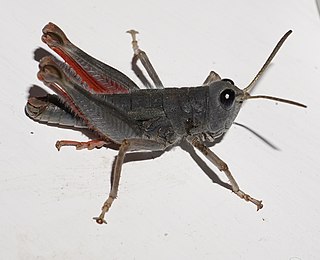
Sigaus villosus is New Zealand's largest grasshopper. It is only found in the central mountains of the South Island. The genus Sigaus is endemic to the New Zealand. Like all of New Zealand sub-alpine and alpine grasshoppers S. villosus has a 2 or 3 years life cycle. The eggs must ‘overwinter’ before they will hatch. Hoppers are found throughout the year and adult grasshoppers can be found throughout the New Zealand summer between December and April. Adult S. villosus do not overwinter.

Sigaus tumidicauda is a species of alpine grasshopper, endemic to New Zealand. Like all of New Zealand sub-alpine and alpine grasshoppers, S. tumidicauda has a 2- or 3-year life cycle. The eggs must "overwinter" before they will hatch. Hoppers are found throughout the year, and adult grasshoppers can be found throughout the New Zealand summer between December and April. This grasshopper is flightless.

Sigaus is a genus of grasshoppers in the tribe Catantopini that is endemic to New Zealand. All but one Sigaus species is endemic to the South Island: Sigaus piliferus is the only North Island representative and is the type species. Most species in this genus are restricted to alpine habitats. All are wingless and make no sounds.

Sigaus australis is the most common alpine grasshopper found in New Zealand. It can be found in the southern half of the South Island above the tree line. Sigaus australis was described in 1897 by Frederick Hutton. Like all of New Zealand sub-alpine and alpine grasshoppers S. australis has a 2 or 3 years life cycle. Individuals can survive the cold by freezing solid at any life stage, at any time of the year. Sigaus australis adults are relatively large grasshoppers. The genus Sigaus is endemic to New Zealand.

Sigaus crassicauda is a species of alpine grasshopper endemic to New Zealand. Like all of New Zealand sub-alpine and alpine grasshoppers S. crassicauda has a 2 or 3 years life cycle. The eggs must ‘overwinter’ before they will hatch. Grasshoppers are found throughout the year and adult grasshoppers can be found throughout the New Zealand summer between December and April. Sigaus crassicauda cannot fly.

Phaulacridium marginale is a small species of short-horned grasshopper in the family Acrididae. It is endemic to New Zealand where it is found in low elevation open habitat throughout North Island, South Island, Stewart Island and on many smaller islands.

Phaulacridium otagoense is an endemic New Zealand grasshopper found at low elevation throughout the central South Island.
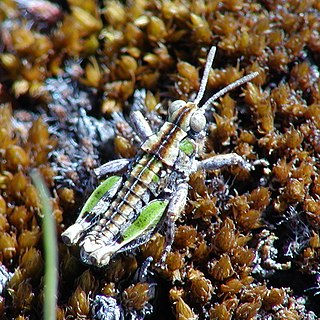
Sigaus minutus is a species of short-horned grasshopper in the family Acrididae. It is one of the smallest and rarest species of grasshopper in New Zealand, found only in the Mackenzie district of South Island. There are 13 species within the genus Sigaus described by Bigelow (1967), all endemic to New Zealand. The population status of Sigaus minutus is declining according to threat assessments made by orthopteran experts in 2010.
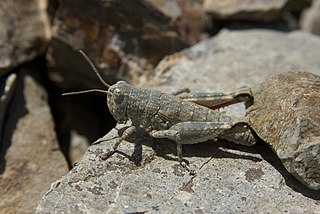
Sigaus nivalis, is an alpine short-horned grasshopper, endemic to the South Island of New Zealand. Sigaus nivalis is brachypterous and flightless, therefore they travel by hopping. They bask during the day so need open habitat.
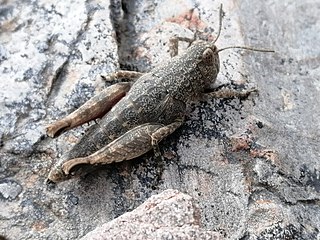
Brachaspis is a genus of grasshoppers belonging to the family Acrididae.
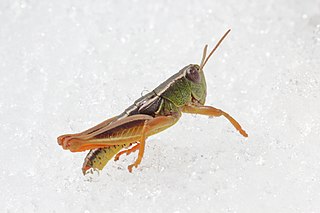
Paprides is a genus of short-horned grasshoppers in the family Acrididae. There are at least two described species in Paprides, found in New Zealand. Both species were moved to the genus Sigaus in 2023
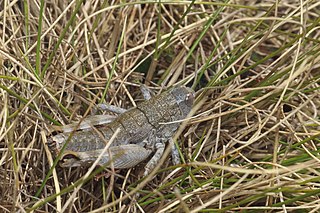
The Green Rock-hopper grasshopper, Sigaus collinus is an alpine species of short-horned grasshopper in the family Acrididae. It is found in New Zealand in the mountains of northern South Island, above the tree line and as high as 2000 m asl. In New Zealand alpine grasshoppers can freeze solid at any time of the year and are alive when they thaw out when temperatures rise.

Sigaus nitidus is a species of alpine short-horned grasshopper in the family Acrididae. It is found in New Zealand. This grasshopper species is flightless and silent.

The ground wētā population near Lake Tekapo New Zealand might represent a distinct species but it has not been formally described. The informal 'tag' name Hemiandrus'furoviarius' was given to this population by Peter Johns in 2001. Commonly known as the Tekapo ground wētā, it is a wētā of the family Anostostomatidae. They are a small, flightless, and nocturnal orthopteran endemic to the Mackenzie Basin of New Zealand's South Island.

Sigaus nitidus is a species of short-horned grasshopper in the family Acrididae, endemic to New Zealand. This alpine grasshopper species is flightless and silent.

























